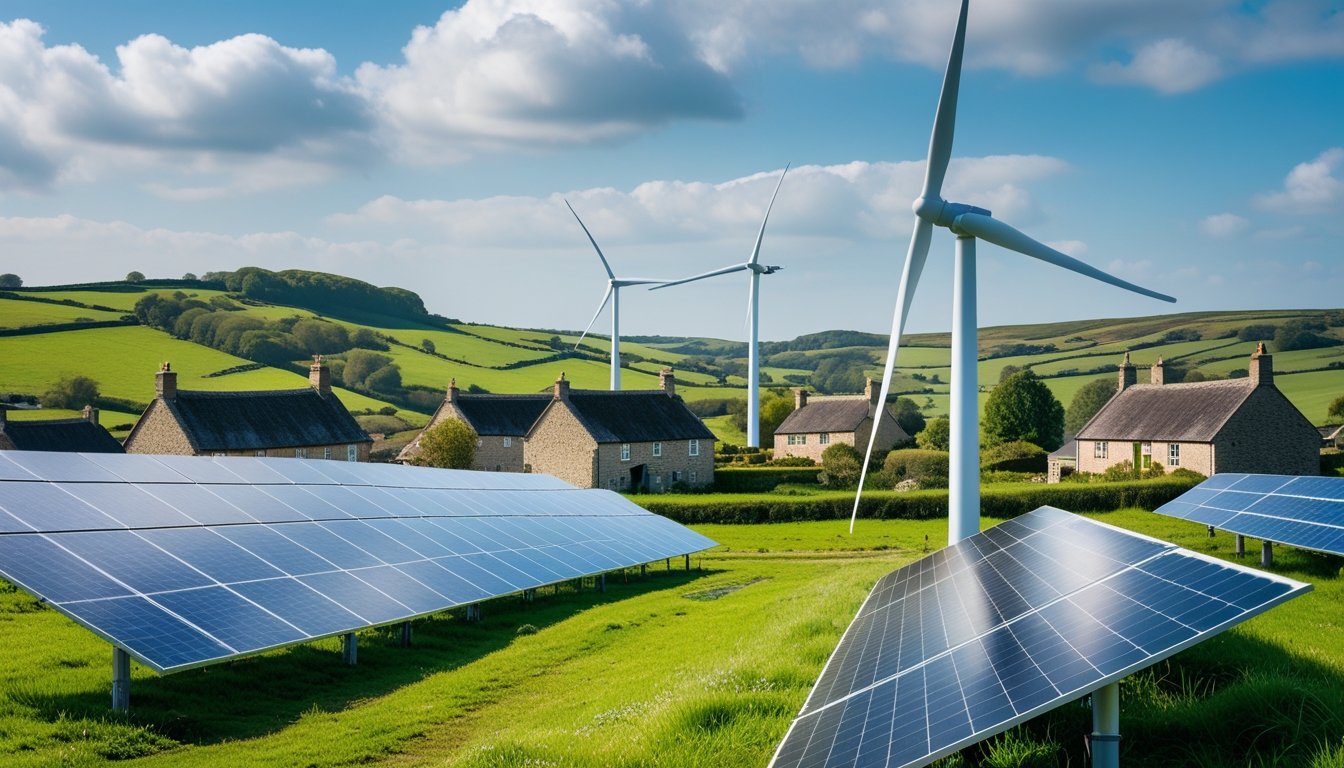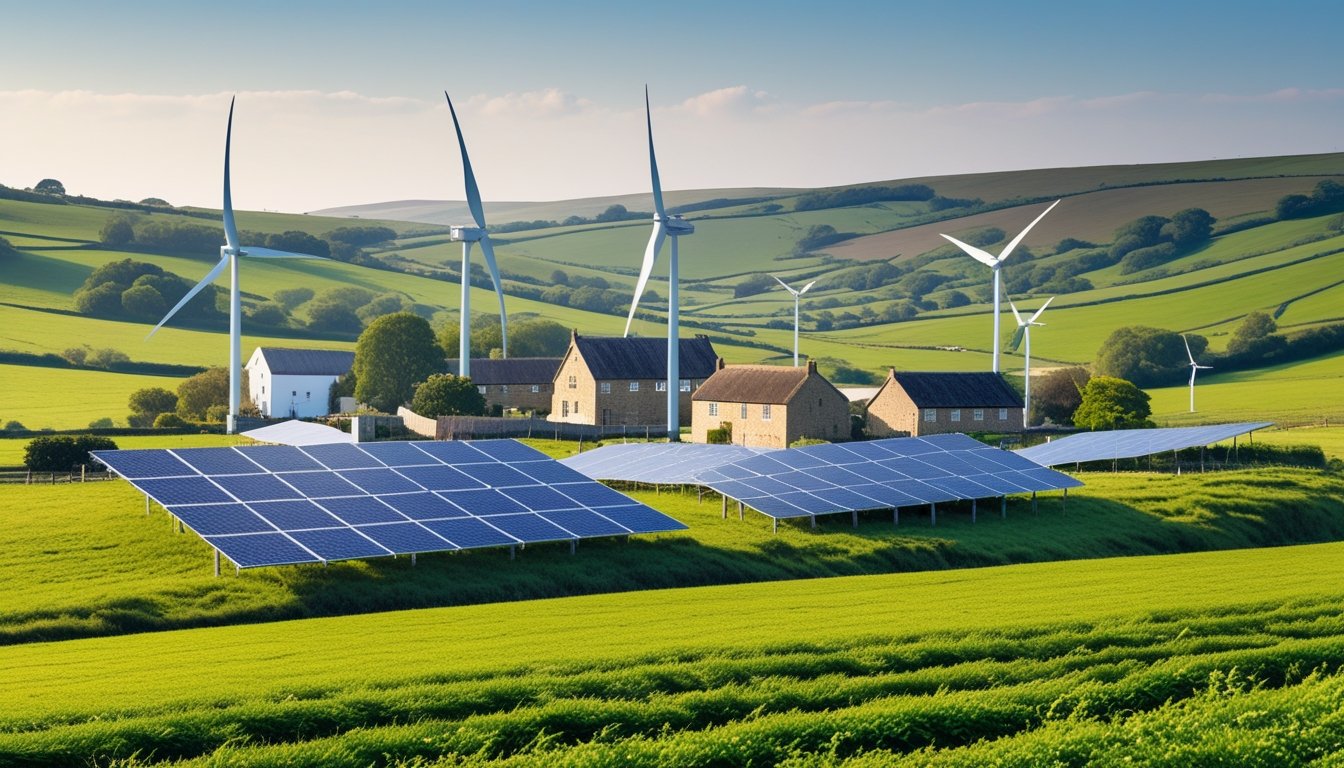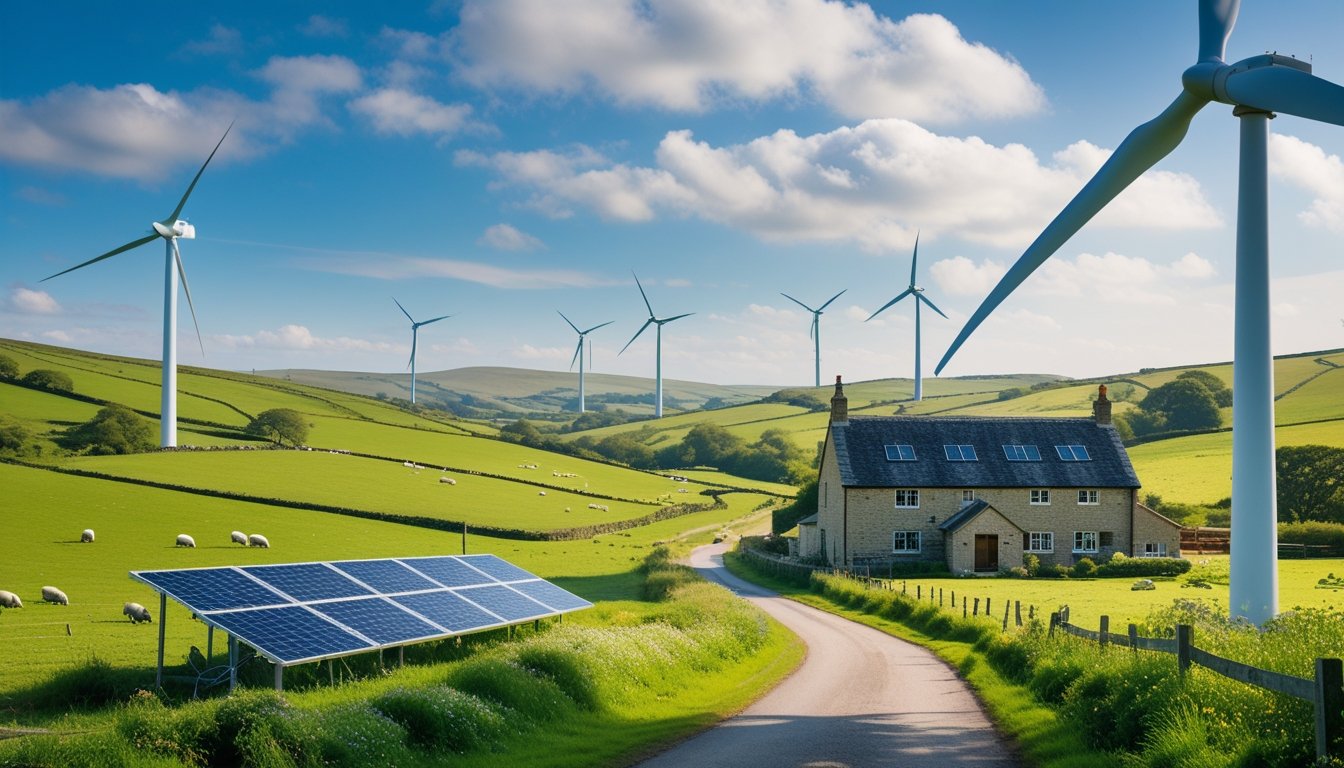Late updated: 22 Oct 2025 09:10
Written by: Oliver Bennett
UK Countryside Innovations In Renewable Energy Use: Transforming Rural Landscapes
The UK countryside is undergoing a remarkable transformation through renewable energy innovations. Amidst rolling hills and rural landscapes, the integration of wind turbines, solar farms, and biomass systems is not only reshaping the energy landscape but also promoting sustainability and reducing carbon footprints. These efforts are making significant strides towards ensuring a clean, affordable, and reliable energy future for the UK.

Our focus on renewable energy is pivotal in speeding the transition to a low-carbon countryside. By emphasising the deployment of renewables in harmony with nature, we can preserve the most fertile agricultural lands and minimise impacts on wildlife. These strategies create a win-win scenario, where energy needs are met while maintaining ecological balance.
Investments in clean energy infrastructure continue to grow, with regions like Scotland, Yorkshire, and the East of England becoming benchmarks in sustainability. By capitalising on advancements in renewable technologies, we’re not only powering our future but also setting new standards for other regions to follow. Our countryside is at the forefront, leading the charge into a greener era.
Key Takeaways
- UK countryside is pivotal in renewable energy innovations.
- Win-win strategy for energy needs and ecological balance.
- Regions setting sustainability benchmarks for others.
Key Innovations Shaping Renewable Energy Use in the UK Countryside
The UK countryside is witnessing a renaissance in renewable energy innovations. These developments are transforming rural landscapes and contributing significantly to sustainable energy production. Here, we explore how wind power, solar energy, biomass, and energy storage are shaping this transformation.
Wind Power Advancements and Rural Integration
Wind energy has surged as a critical component of the UK's renewable strategy. Wind turbines, often towering over the countryside, are a common sight. Recent technological advancements have improved their efficiency and decreased noise, making them more compatible with rural environments.
Offshore wind farms are a significant part of this shift. They harness stronger and more consistent winds at sea, allowing for substantial energy generation without disturbing inland rural landscapes. Additionally, smaller onshore turbines are being integrated into farms and estates, offering landowners a dual income through energy production and farming. Smart grids help manage this dispersed energy efficiently, ensuring stable supply and reducing waste.
Solar Energy Developments and Solar Farms
Solar power is another pillar of the UK’s clean energy initiative. Solar farms are increasingly populating the countryside, transforming unproductive land into energy-rich landscapes. Recent improvements in solar panel efficiency have allowed for greater energy capture, even on cloudy days, which are frequent in the UK.
Farmers and landowners are increasingly installing panels on barn roofs and unused land, generating additional income and contributing to decentralised energy resources (DERs). Innovative tracking systems tilt panels to follow the sun's path, maximising sunlight capture. This synergy between agriculture and technology is a key factor in the rural uptake of solar energy.
Innovative Biomass and Bioenergy Technologies
Biomass and bioenergy are providing sustainable alternatives to traditional fossil fuels. Using organic materials from farms and woodland, these technologies convert waste into energy. This helps reduce landfill use and offers a renewable energy source.
Rural areas, rich in agricultural resources, are natural hubs for biomass production. Farmers are now able to turn animal waste and crop residues into biogas. This energy innovation not only provides clean power but also reduces methane emissions, contributing to broader environmental goals. Efforts are underway to improve the efficiency and scalability of these systems, making bioenergy a substantial player in the clean energy landscape.
Energy Storage Systems and Grid Stability
Energy storage is pivotal in balancing renewable energy supply and demand. Advanced batteries are being developed to store surplus energy from wind and solar, ensuring grid stability. These systems allow for the consistent integration of renewable resources.
The development of smart grids supports this by managing energy flow and reducing losses. Rural areas benefit by storing energy when production exceeds use, and releasing it during peak demand. This capability is vital for maintaining a reliable energy supply, enhancing the resilience of the countryside in the face of fluctuating energy outputs.
Energy storage innovations are enhancing the reliability and attractiveness of renewable projects, helping to secure the UK's energy future with cleaner, more efficient solutions.
Economic, Environmental, and Policy Impacts on the Countryside Transition

With the transition towards renewable energy, the UK countryside is undergoing significant changes across economic, environmental, and policy dimensions. The integration of sustainable practices ensures benefits such as enhanced energy security and reduced carbon emissions while also aligning with national climate goals.
Government Support and Strategic Frameworks
Government support plays a vital role in facilitating the countryside's energy transition. Initiatives focus on enhancing energy security by promoting sustainable energy, such as green hydrogen and bioenergy. Policies are geared towards reducing our carbon footprints and combating climate change impacts. Investment and incentives align with achieving a low-carbon economy, which encourages green technologies' adoption and drives economic growth within rural areas.
Sustainable Land Management Practices
Sustainable land management practices are crucial to maintaining the environmental balance during the transition. By adopting such approaches, we aim to reduce the impact of renewable energy installations on local ecosystems. These practices promote energy efficiency and sustainable development, ensuring long-term viability. Regenerative agriculture and afforestation contribute to carbon emissions reduction while enhancing biodiversity and maintaining natural landscapes.
Energy Security, Carbon Reductions, and Climate Change Mitigation
Renewable energy advancements bolster UK’s energy security. By decreasing reliance on fossil fuels, we cut down greenhouse gas emissions. This shift provides a significant reduction in carbon emissions, a key factor in climate change mitigation. Strategic investments in technologies like wind, solar, and green hydrogen ensure consistent energy availability and sustainability, which are critical for supporting our countryside's economy and addressing climate change challenges.
Frequently Asked Questions

In the UK countryside, renewable energy innovations are actively transforming rural landscapes. By integrating cutting-edge technologies and receiving government backing, these areas are becoming leaders in sustainable energy practices while also fostering robust rural economies.
What are the leading renewable energy technologies being implemented in rural areas of the UK?
Wind and solar power technologies dominate the renewable energy landscape in rural UK. These technologies are being strategically deployed to leverage the abundant wind resources and sunlight found in these regions. Biomass, as well, is gaining traction due to its availability and compatibility with rural agricultural activities.
How are UK countryside communities overcoming challenges associated with renewable energy adoption?
Communities are fostering collaboration and engaging in local initiatives to address the challenges of renewable energy adoption. By participating in cooperatives and community-owned projects, residents can share the financial burden and reap benefits collectively. Education and training programmes further empower communities, equipping them with the knowledge needed to manage and maintain renewable systems.
In what ways is the UK government supporting innovation in renewable energy within the countryside?
The UK government is actively facilitating renewable energy innovation through various means. Financial incentives, such as grants and subsidies, are available for projects in rural areas. Policy initiatives that strengthen grid infrastructure also play a critical role, ensuring efficient energy distribution and storage to support remote communities.
What are the environmental impacts of renewable energy projects on the UK's rural landscapes?
Renewable energy projects in rural UK generally have a minimal environmental footprint. Solar panels are installed on existing infrastructure, while wind turbines are situated to avoid interference with agricultural activities. Careful planning ensures that these projects protect local wildlife and ecosystems, maintaining biodiversity while contributing to carbon emission reductions.
How is renewable energy contributing to the sustainability of the UK agricultural sector?
Renewable energy enhances agricultural sustainability by providing farmers with an additional income stream. By installing wind turbines or solar panels, farmers can generate their own power and sell excess energy back to the grid. This shift reduces reliance on fossil fuels and encourages more sustainable farming practices throughout the sector.
Can you cite successful examples of renewable energy initiatives that have transformed rural economies in the UK?
One notable example is the community-owned wind farm projects in Scotland, which have brought economic benefits to local residents. By giving communities ownership stakes in renewable projects, they benefit from profits which are then reinvested into local infrastructure and services, creating a ripple effect that strengthens rural economies.
